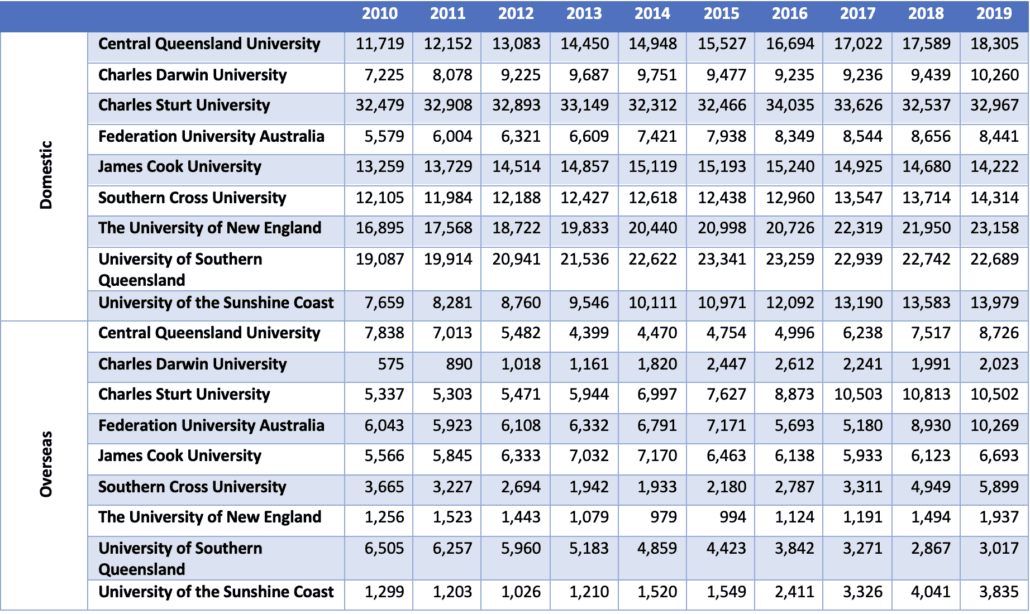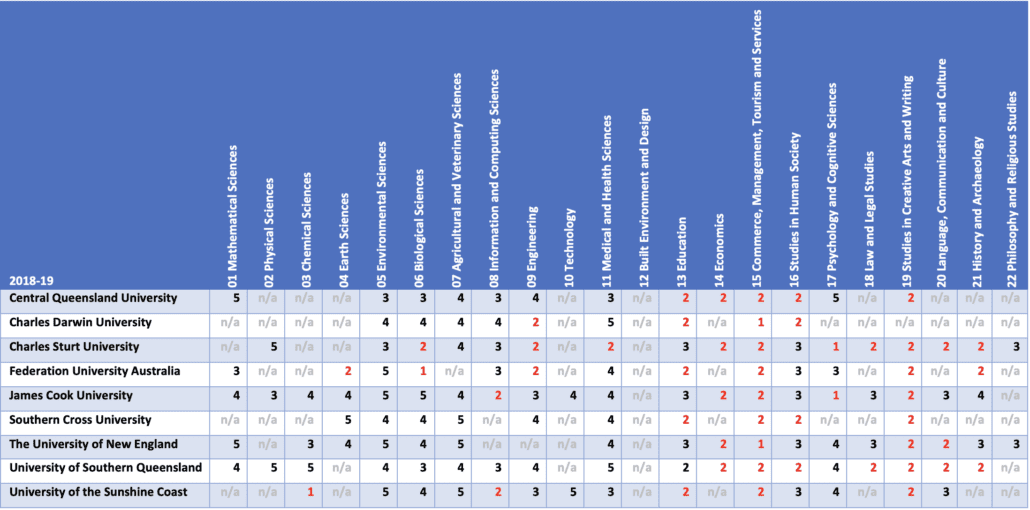
Australia’s regional universities in the post-COVID era
The post-COVID era looms as a particularly challenging one for a number of regional Australian universities. A former senior university leader suggested to me recently that Australia could be looking at mergers of some regional universities as a result of:
- the explicit requirement for research excellence in the new Higher Education Provider Category Standards (for universities to retain their status as a university)
- the Job-ready Graduates funding changes which remove the unfunded research component of the Commonwealth Grants Scheme and the subsequent lack of any progress on a mechanism to separately allocate that research funding (beyond the one-off $1 billion investment in research 2021 and specific targeted research funding programs in the 2022 Budget), and
- declining international student revenues during COVID (with this revenue helping fund research).
Those universities which relied heavily on international student revenues to support their research activities are also going to be looking to rebuild their international student numbers at a time when the new Australian International Education Strategy is focussed on increasing the diversity of the international student cohort in Australia and on more offshore delivery. Both of these activities incur additional costs and thus reduce the funding available from international education which can support research activities.
Higher Education Provider Category Standards
Before unpacking how different regional universities are placed after the pandemic, including in terms of the excellence of their research, some background on the recent changes to the revised Higher Education Provider Category Standards.
In his review of the former Provider Category Standards Prof. Peter Coaldrake (now the Chief Commissioner at TEQSA) stated that “there is great diversity in the quality and quantity of research outputs by Australian universities. Some universities conduct research and deliver higher degrees by research in most fields of education, others in relatively few fields. Some universities conduct research at or above world standard across their entire academic profile, others in relatively few (fields).”
Subsequently the Provider Category Standards were amended in 2021 to include an explicit requirement that universities must undertake world class research in at least 50 per cent of the fields of education they offer to be classified as a university. Since then TEQSA has issued a Determination on how it will assess the Quality of Research and the Australian Research Council has undertaken a review of its Excellence in Research for Australia (ERA). A new assessment round to benchmark university research quality had been scheduled for 2023 but has since been delayed to 2024-25 to allow for a new more data driven approach. Despite the delay in the timing of the next ERA assessment, it seems unlikely that the new approach will set lower benchmarks for research quality, and in fact it seems more likely that standards will be raised. If that proves to be the case it will make it harder for all universities to achieve the levels of excellence they did in 2018 even without the impact of the pandemic and the funding changes they have experienced.
Regional universities facing challenges likely to impact their research activities
Central Queensland University
- achieved an 11% increase in international students between 2010-2019
- international students comprise 32% of all students
- Prof. Frank Larkins in his analysis of the financial performance of Australian universities states that “the pandemic appears to have had most impact financially on Central Queensland (University). It is the one university to report a cash flow deficit in both 2020 and 2021”, and
- was rated excellent (ie a rating of at least 3 out of 5) in 8 out of 13 fields (ie 62%) in the 2018-19 ERA rankings
CQU has been less reliant than some other regional universities on growth in international student revenues to fund its activities, although in 2019 international students made up 32% of the university’s total enrolments. It received $3m in special research funding during the pandemic but lost $178m in total income on 2019 levels. It is possible that if CQU is unable to fund its research activities at its previous level, it may need to reduce the number of fields of education it offers to retain its level of excellence in research and hence its status as a university.
Charles Darwin University
- achieved a 252 per cent increase in international students between 2010 and 2019
- generated an increase in total income between 2020 and 2021 due in large part to a funding increase from the NT government (most of which was capital funding) and the same in 2020 compared to 2019 due to the transfer of property from the City of Darwin. That means that in both years most of the additional income CDU received could not be spent on research (or any other activities), and
- was rated excellent in 5 out of 9 fields of education (56%)
If CDU is unable to maintain the previous level of subsidy from its international student revenues to support its research activities (on top of the loss of research income resulting from the Job-ready Graduates changes) it is possible that it will find it harder to maintain its current level of research excellence. If it drops below a rating of 3 in any of its current 5 fields of excellence it would fall below the 50 per cent threshold in the Provider Category Standards and be in jeopardy of losing its status as a university.
Charles Sturt University
- achieved a 97 per cent increase in international students between 2010 – 2019
- is described by Prof. Frank Larkins as suffering a “very significant reduction in student fee income” in 2020 and 2021, and
- was rated excellent in 7 out of 17 fields (41%)
CSU offers a very broad range of fields of education (17 of a possible 22). Unfortunately even prior to the pandemic (when international student revenues were high) it was not achieving excellence in half of the fields of education it teaches. Given the reduction in fee income CSU experienced during the pandemic and the impact of the closed Australian border on international student numbers, without any additional research funding CSU appears likely to need to reduce the number of fields of education it offers if it is to retain its status as a university in future assessments by TEQSA against the Provider Category Standards.
Federation University
- achieved a 70 per cent increase in international students between 2010 and 2019
- international students comprised 55 per cent of all students at Federation University in 2019
- Prof. Frank Larkins describes the university as having been “severely impacted by the reduction in student fee income” during 2020 and 2021, and
- was rated excellent in 6 out of 13 fields (46%)
Federation University is clearly more reliant than most Australian universities on international student revenues. It appears almost inevitable that the drop in international student numbers experienced during the pandemic will impact its research activities. It therefore seems likely that there will be challenges for Federation University as it looks to retain its rating as excellent in the 7 fields it achieved this ranking in 2018.
Southern Cross University
-
- achieved a 61 per cent increase in international students between 2010 – 2019
- is described by Prof. Frank Larkins as experiencing a “very significant reduction in student fees and charges” in 2020 and 2021, and
- was rated excellent in 6 out of 10 fields (60%)
Although Southern Cross University was rated as excellent in research in 2018 in 60 per cent of its fields of education, it offers education in only 10 fields. It also fared badly during the pandemic in terms of its income – Prof. Larkins notes that SCU received only $3.1m from the government’s special research funding in 2021. By contrast the decline in student fees and charges was so significant that the university suffered a “net two-year reduction” in income of $67m over its 2019 base. Prof. Larkins adds that SCU was also “the only university to report less income in 2021 than in 2020”. Given this it is possible that the university may find it challenging to achieve excellence in all 6 fields of education where it did so in 2018.
Other regional universities were also assessed as part of this analysis and some appear likely to face future challenges in achieving research excellence in all of the fields they did in 2018.
Status of other regional universities post-COVID
James Cook University
- achieved a 20% increase in international students between 2010-2019
- Prof. Frank Larkins notes that James Cook University “received some special one-off funding for 2021” and retained its offshore international student income. It did however experience a “significant reduction” in onshore international student revenues and unlike many other universities, in 2021, chose to divest much of the shares in IDP it had held through Education Australia Limited
- in media reports in 2022 JCU reported experiencing a 25% drop in domestic student numbers in the last few years, and
- was rated excellent in 15 out of 20 fields (75%)
James Cook University has, like other universities, been experiencing financial pressures as a result of COVID and associated university funding reforms. While these may reduce the amount of funding it is able to allocate to its research activities, it seems unlikely to be troubled by the research excellence requirements in the Provider Category Standards. The impact of declining student numbers may instead influence the number of fields of education it continues to offer.
The University of New England
- achieved a 54% increase in international students between 2010-2019, albeit international students comprised only 8% of total students in 2019
- Prof. Frank Larkins notes that “the COVID-19 pandemic has had a small financial impact” on UNE, and
- was rated excellent in 13 out of 15 fields (76%)
The University of New England’s finances were largely unaffected by the pandemic. It appears unlikely to be troubled by the requirements for research excellence in the Provider Category Standards.
The University of Southern Queensland
- achieved a 54% increase in international students between 2010-2019, albeit international students comprised only 12% of total students in 2019
- Prof. Frank Larkins notes that “there were only small changes in student fee income, investment and other incomes” for USQ between 2019 and 2020, and in 2021 it recognised the revenues from its holdings in Education Australia Limited as investment income (some institutions recognised the same revenue as a current asset), and
- was rated excellent in 11 out of 18 fields (61%)
Universities differential treatment of the income from EAL’s holding in IDP makes it more difficult to compare their financial performance in 2021, as Prof. Larkins notes. Nonetheless in 2018 USQ achieved research excellence in a large number of fields of education and it has minimal exposure to (and reliance on) international student revenues. It therefore appears likely that USQ will not find it as difficult as some other regional universities to continue to achieve excellence in research in at least 50% of the fields it offers.
University of the Sunshine Coast
- achieved a 195% increase in international students between 2010-2019
- Prof. Frank Larkins notes that overall there was a small increase in total income between 2019 and 2020 and between 2020 and 2021 (in both years this was largely due to increases in government funding), and
- was rated excellent in 9 out of 14 fields (64%)
Prof. Larkins’ assessment of USC’s finances indicates that “none of the EAL revenue appears to be declared as income in contrast to some other Queensland universities so the true financial performance may be viewed as understated.” With a growing reliance on international student revenues in the past decade and some uncertainty as to the level of additional financial assistance it may receive in future, there may be some challenges for USC in achieving excellence in research in all of the fields it did in 2018.
Data
The regional universities’ domestic and international student numbers 2010-2019 were:

The regional universities’ ERA performance outcomes in 2018-19 were:




